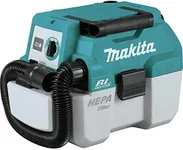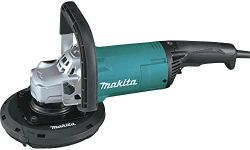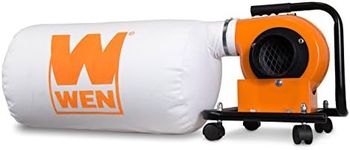Buying Guide for the Best Dust Collectors
Choosing the right dust collector is essential for maintaining a clean and safe working environment, especially in workshops or industrial settings. The right dust collector can help improve air quality, reduce health risks, and enhance the efficiency of your operations. To make an informed decision, you need to understand the key specifications and how they align with your specific needs.Airflow (CFM)Airflow, measured in cubic feet per minute (CFM), indicates the volume of air the dust collector can move. This spec is crucial because it determines the efficiency of dust collection. Higher CFM values mean the dust collector can handle larger volumes of dust and debris. For small workshops or home use, a lower CFM (around 400-600) might be sufficient. For larger industrial settings, you might need a dust collector with a higher CFM (1000+). Consider the size of your workspace and the amount of dust generated to choose the right CFM.
Static Pressure (SP)Static pressure, measured in inches of water gauge (inH2O), indicates the resistance to airflow within the dust collection system. This spec is important because it affects the dust collector's ability to maintain efficient airflow, especially when using long ductwork or multiple collection points. Higher static pressure values mean the dust collector can overcome more resistance. For simple setups with short duct runs, lower static pressure (around 4-6 inH2O) might be adequate. For complex systems with long ducts or multiple machines, look for higher static pressure (8+ inH2O).
Filtration EfficiencyFiltration efficiency refers to the dust collector's ability to capture fine particles. This is important for maintaining air quality and protecting health. Filtration efficiency is often expressed as a percentage or by the size of particles it can capture (e.g., 1 micron). Higher efficiency means better air quality. For general woodworking, a filter that captures particles down to 1 micron is usually sufficient. For more sensitive environments or where fine dust is a concern, look for filters that capture particles down to 0.3 microns or higher efficiency ratings.
Dust Collection CapacityDust collection capacity refers to the volume of dust the collector can hold before it needs to be emptied. This is important for convenience and efficiency, as larger capacities mean less frequent emptying. Capacity is usually measured in gallons or cubic feet. For small workshops, a capacity of 10-20 gallons might be sufficient. For larger operations, look for capacities of 30 gallons or more. Consider the amount of dust your operations generate and how often you want to empty the collector.
Noise LevelNoise level, measured in decibels (dB), indicates how loud the dust collector is during operation. This is important for comfort and safety, especially in environments where noise levels need to be controlled. Lower dB values mean quieter operation. For home workshops or areas where noise is a concern, look for dust collectors with noise levels below 80 dB. In industrial settings where noise is less of an issue, higher noise levels might be acceptable. Consider your working environment and noise tolerance when choosing a dust collector.
PortabilityPortability refers to the ease with which the dust collector can be moved around. This is important if you need to use the dust collector in different locations or if space is limited. Portable dust collectors are usually smaller and have wheels for easy movement. For small workshops or where flexibility is needed, a portable dust collector might be ideal. For larger, stationary setups, portability might be less of a concern. Consider how often you need to move the dust collector and the layout of your workspace.













![IMPRESA [2-Pack] Drill Dust Collector for Projects with Power Drills - Traps Dust & Debris Caused by Cordless Drill - Pocket-Sized Drill Bit Set Accessory - No Extractor Vacuum Necessary](https://images-proxy.bestreviews.guide/LUpw2jlV15hvSXlxSq_nWCme2ac=/0x150/https://m.media-amazon.com/images/I/31aU7yhcvsL._AC_CX679_.jpg)








